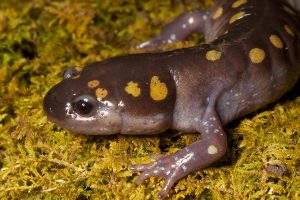Research Highlights: Exploring the limits of biological adaptation to climate change
By Jared Homola, IGERT Fellow and Ph.D. Student in Ecology and Environmental Sciences at UMaine
Background
Animal populations subjected to climate change generally face three options: maladaptation and localized population declines, biological adaptation to new conditions, or range shifts into suitable habitat. However, the distinction of these options is likely artificial, as many species are expected to experience all three responses to some degree. Additionally, the magnitude and interactions of these different responses are expected to depend on patterns of climate change and interactions with other human-related landscape changes.
Biological adaptation is a lesser studied, but potentially vital response to climate change. The importance of the role of adaptation is emphasized by considering the magnitude of range shift necessary to compensate for predicated changes. Temperature changes of 1°C equate to an average range shift of about 160 km (100 mi); therefore, under the predicted 4°C increase over the next century, many species may require a range shift of over 500 km (310 mi). Some highly mobile species may be able to accomplish such large-scale range shifts, but the vast majority of the world’s biodiversity likely faces dispersal limits on such short time frames. For those species, survival may depend both on adaptation and localized movement of individuals.

Research
My dissertation research focuses on Maine’s vernal pool amphibian populations to examine species’ responses to environmental change. Vernal pools and the amphibians that depend on them provide an interesting setting for considering the roles of biological adaptation and localized dispersal as climate change adaptation strategies. For example, these shallow aquatic environments are particularly responsive to climatic variation, yet they make a notably large contribution to ecosystem services (e.g., carbon sequestration) and maintenance of biodiversity. The wood frogs and spotted salamanders that depend on vernal pools present a potentially interesting contrast for climate change adaptation strategies: wood frogs disperse broadly during short generation times, while spotted salamanders have more limited dispersal over longer generation times. Additionally, both species are considered “spatially structured,” meaning that they are distributed throughout the landscape in small subpopulations that are often connected through occasional movement of individuals among locations. This characteristic makes these amphibian species useful indicators for better understanding how other spatially structured species will respond to climate change.

My research combines two different approaches, landscape genetics, and agent-based modeling, to better understand the roles of range shifts and biological adaptation for influencing spatially structured species’ population persistence in response to climate change. The landscape genetic methods are able to quantify the degree of genetic similarity that exists among different populations, which can then be used to infer how frequently individuals move among populations. Additionally, these analyses provide information on which landscape features are more likely to slow movement of individuals (e.g., roadways and rivers), consequently providing insight into how landscapes may influence the likelihood of range shift being a viable climate change adaptation strategy.

Information gained from the landscape genetic analyses of how connected populations are through individual dispersal is then being used to construct an agent-based model. Agent-based models simulate the activities of individual entities as they interact with one another and the virtual landscape they exist upon. Altering the landscape throughout the course of the simulation allows me to ask a variety of “what if” questions regarding population persistence under various climate change scenarios (Figure 1). For instance, “Would a five-year drought that temporarily reduces the number of vernal pools on the landscape cause long-term declines in amphibian abundance across Maine?” That question can be further examined by comparing the likelihood of persistence for population located in highly fragmented urban landscapes versus those in relatively undisturbed rural settings.

Understanding the interplay between ecological processes such as individual movement and adaptive evolutionary processes will be essential for identifying suitable biodiversity conservation strategies as climate change continues to progress. When properly parameterized for other species, the model that I am developing will provide a valuable tool for anticipating species’ response to climate change occurring across real, complex landscapes.
Learn more about my research and other students’ research on Maine’s vernal pool amphibians by visiting the Of Pools and People website’s blog and follow the activities of our research group on the Of Pools and People Facebook page.
